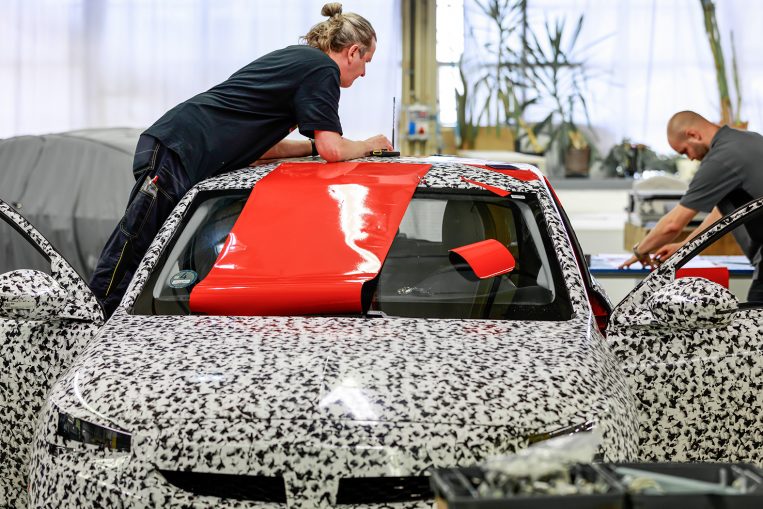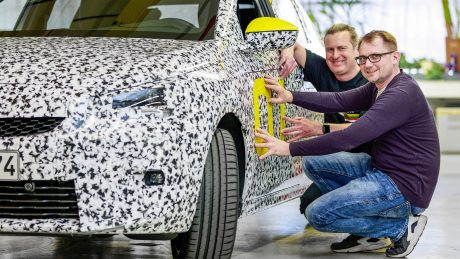- Festgehalten: Andreas Kubis und Ralf Neumann aus dem Camouflage-Team platzieren die Startnummer „01“ an einem Corsa-Prototypen, der für die Validation Drives eine individuelle Folierung erhält.
01 / 02
Yellow and red foils give the prototypes an individual touch –
and provide a means of differentiation.
A game with cards face down is about keeping as much secret as possible. Replacing “cards” with “cars” is the core of the work of Andreas Kubis’ camouflage team. It is responsible for covering Opel prototypes. Their current permanent guest: the new Opel Corsa.
In recent weeks, the camouflage experts have had their hands full with the sixth generation of the small car. No fewer than 140 cars have been covered with foil. “The pre-series vehicles are used for a wide variety of testing purposes,” says Kubis, who started his career at Opel in 1995 and has been working as Technical Specialist Camouflage since 2012.
In the specifications of the colleagues were vehicles for test drives in the Swedish Arjeplog or for the Validation Drives in the Palatinate and Lorraine. As the European journalists examined the driving characteristics of two different engines, the team had to come up with something special for this exclusive event.
![]()

Meticulously and precisely: Ralf Neumann and Pierre Wohn (from left) from the Camouflage team attach the exceptionally coloured foil to a pre-series model of the Corsa.
![]()

Smoothed: Just like the black-and-white 3D patterned foil, the single-colour plastic should not form bubbles.
![]()
![]()
“The design of the new Corsa generally has many edges, corners and indentations.”
“We gave the prototypes an additional red or yellow foil in order to be able to distinguish the vehicles externally,” explains Kubis. It took the Camouflage team around three hours each to apply the coloured plastic strips. On the outside mirrors, above and below the front doors, on the roof, above the rear fenders across the rear as well as on the rims.
Additional red and yellow numbers – “01” and “02” – on the driver and passenger doors gave the newcomer and the test drives exactly the sporty character that the winding country roads in the Franco-German border region brought with them. After all, the two red-clad Erlkönigen were fitted with a 1.2 turbo engine with 100 hp and six-speed manual transmission, the yellow-clad models with a 1.2-litre turbo petrol engine with 130 hp and eight-speed automatic transmission.
![]()

Chief guardian of Opel design: Andreas Kubis, who started his apprenticeship as an industrial mechanic at Opel in 1995, has been responsible for camouflage since 2012.
![]()

Optical differentiation: The yellow and red foils indicate which motorization is integrated in the prototypes.
![]()
“It will still take a few weeks until the car will be shown to the public completely uncovered.”
“The design of the new Corsa generally has many edges, corners and indentations. That’s why we didn’t use 3D components this time,” Kubis continues. “Nevertheless, we built a lot underneath – that’s just part of the camouflage.”
Kubis developed the black and white film himself. It has also protected the Insignia from prying eyes. The team tailored about 85 of the 60×40 centimetre arches to each individual Corsa prototype, which was allowed to be on the road sooner.
The camouflaged Corsa specimens will also be found there in the coming weeks. “Until the car is ready for series production, our engineers still have to carry out some tests with the Erlkönigen. It will therefore still take a few weeks until the car will be shown to the public completely uncovered,” says Kubis.
The recently published pictures of the Corsa-e give a foretaste of what’s under the camouflage dress. Until the official world premiere at the IAA, however, the development engineers will continue the game with the hidden rides.
![]()

Through woods and open country: one of the prototypes of the sixth Corsa generation, that took part of the Validation Drives in the Palatinate and Lorraine. The order books for the new Corsa will open in a few weeks, beginning with the Corsa-e, followed by the diesel and petrol versions.
June 2019

